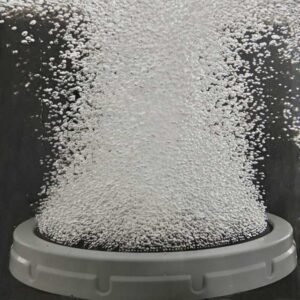
How Does Aeration Work In Water Treatment ?
How does aeration work in water treatment?
Today we’re going to take a deeper, more technical look at how aeration “works” in water treatment. The process combines physical and biochemical principles.
We can decompose the working mechanism of aeration into the following three levels:

I: The process of physical mass transfer: How to “dissolve” oxygen into water
This is the most basic working step of aeration. The process of transferring oxygen from the gas phase (air) to the liquid phase (water) is a physical mass transfer process.
• Bubble generation: The core function of aeration equipment is to create a large gas-liquid contact area. It produces countless tiny bubbles or breaks up air into small bubbles through vigorous stirring, greatly increasing the contact surface area between air and water.
• Transfer of gas: In the process of rising bubbles in water, the oxygen inside them will pass through the gas-liquid interface membrane and gradually dissolve into the surrounding water body, becoming dissolved oxygen.
• Bubble size: The smaller the bubble, the larger the total surface area and the higher the oxygen transfer efficiency. This is why micropermeable aeration is more efficient and energy efficient than atmospheric aeration.
• Contact time: The longer the bubbles stay in the water, the more time oxygen has to dissolve. Deep aeration tanks provide longer bubble rise paths, thus prolonging contact time.
• Oxygen partial pressure gradient: the more oxygen is deficient in water, the stronger and faster the driving force of oxygen transfer from bubbles to water.
Simple analogy: It’s like shaking a bottle of mineral water vigorously to dissolve more carbon dioxide into the water; aeration is a more efficient and controlled process of “filling” (oxygenating) the water.
II: Biochemical processes: How oxygen purifies sewage
This is the core value of aeration in sewage treatment. Dissolved oxygen itself does not directly purify sewage, but acts as a key “fuel” to drive a large microbial ecosystem.
• Fuel supply: The dissolved oxygen provided by the aeration system is necessary for the survival and reproduction of aerobic microorganisms. These microorganisms form activated sludge flocs in the aeration tank.
• Microbes “eat”: These aerobic microbes use organic pollutants in the water as their food.
• Respiration (oxidation and decomposition): Microorganisms use the dissolved oxygen we provide to oxidize and decompose these organic matter through “respiration”. Final product: The organic matter is completely decomposed into harmless carbon dioxide and water, and release energy for microbial growth and reproduction.
• Nitrification: With sufficient oxygen and a long residence time, another group of bacteria (nitrobacteria) can convert toxic ammonia nitrogen in the water into nitrate, a process that also consumes a lot of oxygen.
Simple analogy: The aeration tank is like a giant, efficient “microbial farm”, where we aerate the workers (aerobic microbes) to give them the oxygen they need to breathe, and let them eat up the pollutants in the water.
III: Fluid dynamics processes: How to make the system “efficient”
Aeration not only supplies oxygen, but also ensures the efficient and stable operation of the whole reactor through fluid dynamics.
• Mixing and stirring: The bubbles produce a violent stirring effect on the water body during the rising process, so that the microorganisms can always contact the “food” and “oxygen”. The activated sludge flocs are kept in suspension to prevent them from settling at the bottom of the tank, and ensure the uniform reaction of the whole system.
• Maintaining an aerobic environment: continuous stirring and oxygenation ensure that the whole reaction tank is in a stable aerobic state, inhibit the activity of anaerobic bacteria, and prevent the production of smelly gases such as hydrogen sulfide and methane.

Summary: The whole aeration process can be summarized as an efficient supply chain:
Operation of aeration equipment → Generation of bubbles and increase of dissolved oxygen → Microorganisms obtain oxygen → Microorganisms oxidize and decompose pollutants → Mixing action to maintain uniform mixing → Purified water enters the next link.
Therefore, aeration is not a single action, but a complex and exquisite engineering process integrating gas transfer, biochemical reaction and fluid mixing, which is the core of modern water treatment, especially in the field of biochemical treatment.
Our company provides high quality and stable products, including reverse osmosis system, sludge dewatering machine, mechanical grille, dosing device, electrical control cabinet, etc., our professionals will provide you with installation, commissioning, operation, and follow-up maintenance services to help you solve problems!
Yixing Shenghe Environmental Protection Co., Ltd.

IPv6 network supported